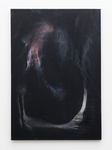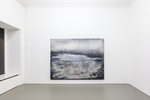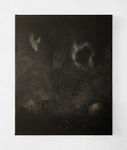Kyle Fitzpatrick - Parsimony
The large-format paintings by Kyle Fitzpatrick are dark and almost radically empty. They change between abstraction and figurative elements due to their monochrome black-brownish or night-blue surfaces and the few, bright parts. The bright areas seem like light coming from nowhere, which falls on gloomy, often melancholy-looking, deserted landscapes. These ghostly landscapes, which give us a dark longing for nature, are not life-worldly and can not be assigned territorial, social, political or geographical landscapes. The paintings lack conventional perspectives; dark amorphous realms wipe out everything and have a depressing, even nihilistic effect. They are like the stillness of the now at the end of the world, where the visible world is only a small part of reality - it is that moment which counts.
Whether you are exhilarated or depressed, it seems that something of yourself remains in the hushed thickets and in the branches of the mute trees… According to whether you’re sanguine or somber, nature celebrates with you or consoles… You see nature agitated or at ease, according to what is happening within yourself. (Paul Mantz (1821-1895), French art critic)
Parsimony, the title of the exhibition (the German, “Sparsamkeit”), describes the moderate handling of available resources in an optimal way. Thrift is a goal to be achieved by using only what is necessary. It's a virtue and should not be confused with stinginess. Avarice, on the other hand, is exaggerated thriftiness and an unwillingness to share, thus related to covetousness, acquisitiveness and greed.
In our time, however, which is characterized by massive exploitation of natural resources of our planet, massive total indebtedness of private individuals and looming state failures, one should do well to internalize economical and moderate handling of things and means.
Kyle Fitzpatrick's "Parsimony" refers to the essay "Migratory Meaning" by Ron Silliman on the poem, "Migratory Noon" by Joseph Ceravolo.
Silliman argues here that any attempts to integrate elements of this poetry into a coherent reading are thwarted, since they elude a detailed and precise determination and there is even an apparent incoherence or inconsistency between parts of the same sentence. He continues to argue, however, that the perceptible determination of each object allows one to interpret the whole, which in turn is due to the, "parsimony principle" that takes place in the mind of the reader. The "parsimony principle", according to the linguists Charles Fillmore and Paul Kay, refers to the tendency of the reader to combine individual images with a maximum of standardization through a minimum of effort, thus placing the reader in the foreground of elements that fit into specific contexts, and ignores those that prevent such reading.
The two linguists Charles Fillmore and Paul Kay in turn derive their principle of parsimony from the so-called, "Ockham's razor", named after William of Ockham (1288-1347) which states that in the case of several possible explanations for one and the same state of affairs, the simplest theory is to be preferred. A theory is simple if it contains as few variables and hypotheses as possible, and if these are in clear, logical relationships to each other, the matter to be explained follows logically.
The increasing differentiation and detailed description of a phenomenon is not per se a worse or less true description of reality. However, a differentiated description should also create some added value.
Ron Silliman, "Migratory Meaning," 1982, The New Sentence (New York: Roof Books, 1995), 109, 119)
Text: Bernd Reiss
Migratory Noon
Joseph Ceravolo
Cold and the cranes.
Cranes in the
wind
like cellophane tape
on a school book.
The wind bangs
the car, but I sing out loud,
help, help
as sky gets white
and whiter and whiter and whiter.
Where are you
in the reincarnate
blossoms of the cold?
Å+ Kyle Fitzpatrick - Parsimony - Dossi[...]
PDF-Dokument [52.0 MB]









